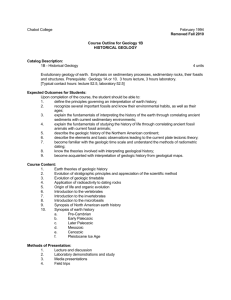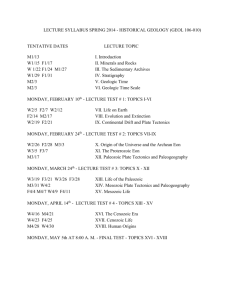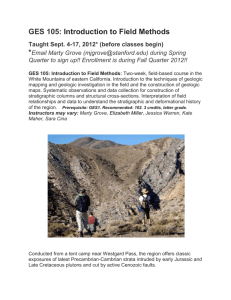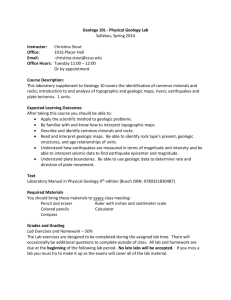GEOL 106
advertisement
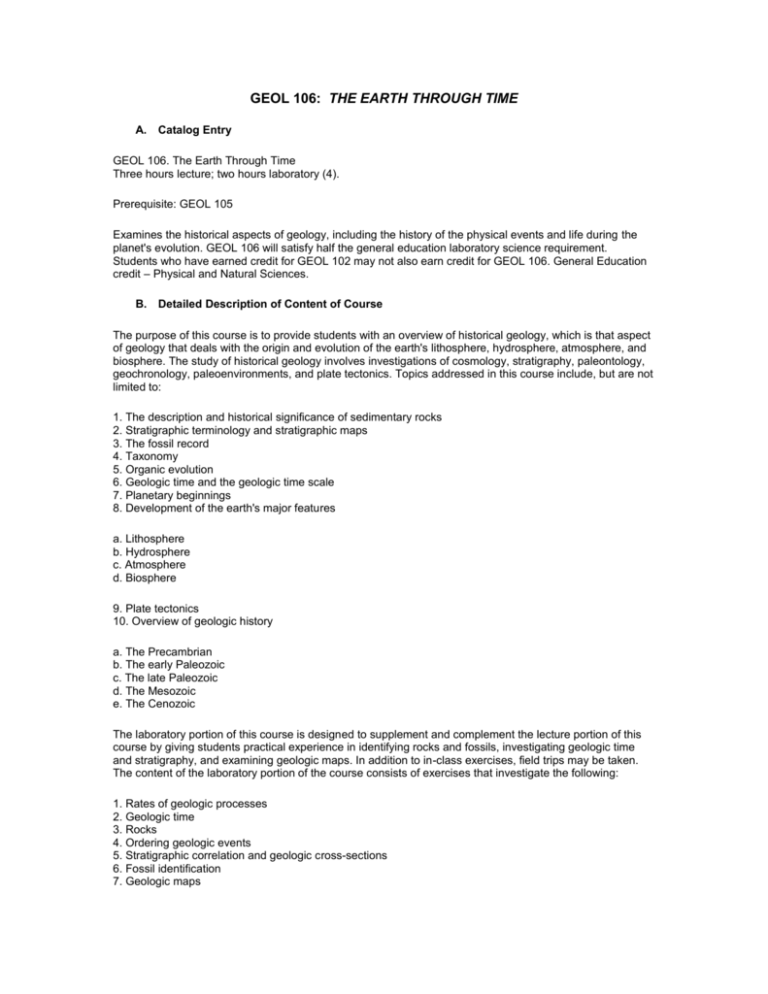
GEOL 106: THE EARTH THROUGH TIME A. Catalog Entry GEOL 106. The Earth Through Time Three hours lecture; two hours laboratory (4). Prerequisite: GEOL 105 Examines the historical aspects of geology, including the history of the physical events and life during the planet's evolution. GEOL 106 will satisfy half the general education laboratory science requirement. Students who have earned credit for GEOL 102 may not also earn credit for GEOL 106. General Education credit – Physical and Natural Sciences. B. Detailed Description of Content of Course The purpose of this course is to provide students with an overview of historical geology, which is that aspect of geology that deals with the origin and evolution of the earth's lithosphere, hydrosphere, atmosphere, and biosphere. The study of historical geology involves investigations of cosmology, stratigraphy, paleontology, geochronology, paleoenvironments, and plate tectonics. Topics addressed in this course include, but are not limited to: 1. The description and historical significance of sedimentary rocks 2. Stratigraphic terminology and stratigraphic maps 3. The fossil record 4. Taxonomy 5. Organic evolution 6. Geologic time and the geologic time scale 7. Planetary beginnings 8. Development of the earth's major features a. Lithosphere b. Hydrosphere c. Atmosphere d. Biosphere 9. Plate tectonics 10. Overview of geologic history a. The Precambrian b. The early Paleozoic c. The late Paleozoic d. The Mesozoic e. The Cenozoic The laboratory portion of this course is designed to supplement and complement the lecture portion of this course by giving students practical experience in identifying rocks and fossils, investigating geologic time and stratigraphy, and examining geologic maps. In addition to in-class exercises, field trips may be taken. The content of the laboratory portion of the course consists of exercises that investigate the following: 1. Rates of geologic processes 2. Geologic time 3. Rocks 4. Ordering geologic events 5. Stratigraphic correlation and geologic cross-sections 6. Fossil identification 7. Geologic maps C. Detailed Description of Conduct of Course Lectures, demonstrations, audio/video presentations, classroom discussions, laboratory exercises and reading assignments will be used. D. Goals and Objectives of Course 1. Students will become acquainted with the scientific method as it applies to geology. 2. Students will gain a fundamental knowledge of the natural history of the earth and the life it supports by examining various aspects of cosmology, the origin and development of the solar system and earth, stratigraphic principles, paleontology, organic evolution, geologic time, plate tectonics, and geologic history with emphasis on North America. 3. Students will apply knowledge gained in lecture to practical problems in the laboratory. 4. Students will demonstrate skills in identifying rocks and fossils, reading and interpreting topographic and geologic maps, calculating the rates of geologic processes, and performing stratigraphic correlation. 5. Geology majors will obtain the background knowledge they will need for their upper level geology courses. E. Assessment Measures Lecture exams, pop quizzes, and a final examination will be used to assess the students' knowledge of geologic history. Laboratory exercises and practical examinations will be used to assess the students' skills in reading topographic maps, identifying fossils and analyzing geologic conditions, and their knowledge of geologic time, rates of geologic processes, and the use of stratigraphic principles in interpreting geologic maps. F. Other Course Information GEOL 106 is a required course for a major and minor in geology. Geology 106 partially fulfills the general education requirement in laboratory science. BIBLIOGRAPHY: AGI/NAGT, 2006, Laboratory Manual in Physical Geology (7th edition), Prentice Hall, Upper Saddle River, New Jersey, 320 p. Attenborough, David, 1979, Life on Earth, Little, Brown and Co., Boston, MA, 319 p. Cloud, Preston, 1988, Oasis in Space Earth History from the Beginning, W. W. Norton & Co., New York, NY, 508 p. Fenton, Carroll L. and Fenton, Mildred A., 1989, The Fossil Book, Doubleday, New York, NY, 740 p. Geology Department, Radford University, 1990, Laboratory Manual for Geology 106, Geology Department, Radford University, Radford, VA, 104 p. Hamblin, W. Kenneth, 1992, Earth's Dynamic Systems (6th edition), Macmillan Publishing Company, New York, NY, 647 p. Hatcher, Robert D., Jr., 1990, Structural Geology, Merrill Publishing Company, Columbus, Ohio, 531 p. Kauffman, Erle G. and Hazel, Joseph E., 1977, Concepts and Methods of Biostratigraphy, Dowden, Hutchinson, & Ross, Inc., Stroudsburg, PA, 658 p. Levin, Harold L., 2003, The Earth Through Time (7th edition), John Wiley & Sons, Somerset, New Jersey, 632 p. Press, Frank and Siever, Raymond, 1986, Earth, W. H. Freeman and Company, New York, NY, 656 p. Readings from Scientific American, 1978, Evolution and the Fossil Record, W. H. Freeman and Co., San Francisco, CA, 222 p. Redfern, Ron, 1983, The Making of a Continent, Times Books, New York, NY, 242 p. Smith, David G. (ed.), 1981, The Cambridge Encyclopedia of Earth Sciences, Crown Publishers, Inc., New York, NY, 496 p. G. Approval and Subsequent Reviews Date Action Reviewed By September 2005 Reviewed and Updated Stephen W. Lenhart, Chair


